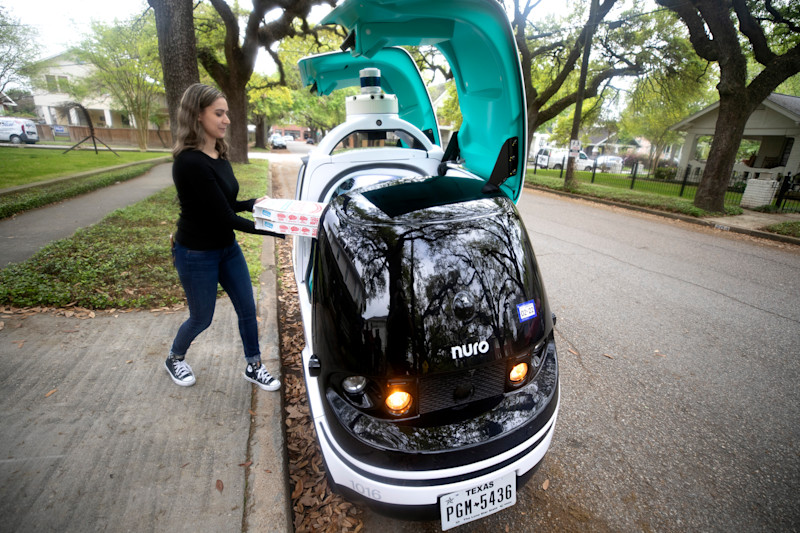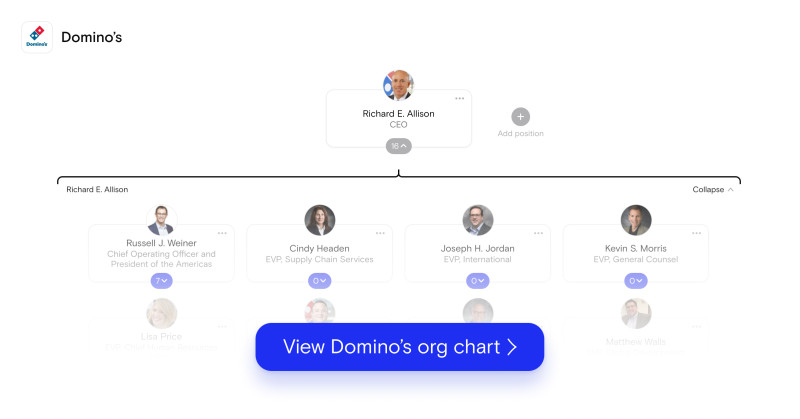The Org Chart for Domino’s Industry-Leading Tech Team
In order to stay competitive with delivery apps like UberEats and Grubhub, Domino's has ramped up its technology operations in recent years to build out its own cutting-edge delivery service — which now includes self-driving robot cars. We dove deep into the org chart to see who the innovators are at the company making all this tech possible.

Right now, ordering a pizza from Domino’s has never been easier, and that’s no coincidence. The largest pizza company in the world based on retail sales, Domino’s generates more than 70% of its U.S. sales through digital ordering channels — in large part due to a leadership team that pivoted the company toward e-commerce nearly a decade ago.
In order to compete with delivery behemoths like UberEats and DoorDash, the digital and tech teams at Domino’s have spent the past eight years developing its AnyWare suite of digital platforms. Customers can just as easily order from their smart TVs and Amazon Alexas as they can from picking up the phone and calling. And on April 12, Domino’s officially launched its self-driving delivery program in Houston with AV company, Nuro, the newest frontier for the pizza company.
Take a look at how Domino’s org chart has evolved over the past decade and how this household name for pizza turned itself into a digital-first technology company.
Former CEO Patrick Doyle has been talking about Domino’s as “a tech company that sells pizza” for years. But this rebrand is more than hitting refresh on a marketing slogan, it’s a survival tactic. Domino’s main competitors are not other pizza chains, but delivery apps run by tech giants backed by tremendous amounts of VC, affording these companies patience and time that the public markets do not. Even its fellow public competitors are still a threat — DoorDash’s $12.6B valuation is worth more than Domino’s market cap of $10.43B.
Sounding the alarm on the need to digitize more than nine years ago, Kevin Vasconi and Kelly Garcia are credited with being the masterminds behind Domino’s tech transformation. Vasconi worked at Domino’s as Chief Information Officer until last year, when Garcia, Domino’s CTO, took over his duties once he left the company.
The pair both started back in 2012 and have been somewhat of a dynamic duo in shaping Domino’s digital strategy. Vasconi, who now works as CIO at Wendy’s, was instrumental in shifting the company’s attitude toward becoming digital-first. Vasconi brought an extensive career working as a CTO for several early internet tech companies and spent eight years as CIO at the automative insights firm R L Polk (now IHS Markit). His familiarity working with data and leading technical teams was appealing for the e-commerce suite Domino’s wanted to build. Similarly, Garcia also came from R L Polk as an experienced app developer.

Both he and Garcia planted the seeds of e-commerce at Domino’s and built out a massive IT team that analyzed what devices customers were using and how Domino’s could make ordering possible on there. In 2015, Garcia announced the AnyWare suite of digital ordering platforms, letting customers order Domino’s through different home devices. The suite now includes 18 different places to order, meaning customers can ask smart assistants to order pizzas, place company orders through Slack, and even request stuffed cheesy bread through Samsung TVs.
The years of work the tech team spent coding to sync up to all these different devices paid off during the pandemic. Domino’s saw same-store sales grow 16.1% in Q2 of 2020 and total worldwide revenue growing 13.1% — bringing in $929 million. And while it missed Wall Street’s projections for Q4, the company still brought in $1.36 billion in worldwide revenue.
Tweaking the overall sales strategy of the company also meant tweaking the org chart. Tim McIntyre, EVP of Communications, said in an email to Forbes that “creating a cohesive team that also includes technology was the primary strategy impetus for this reporting change.” So, unlike Vasconi, who reported directly to the CEO, Garcia reports to COO Russell Weiner and took over the 400-person IT team at the company in October 2020.

E-commerce and software integration was the first big leap into tech, now Domino’s wants to go a step even further and bring AI into the mix. It teamed up with self-driving vehicle company Nuro in 2019 to hit refresh on the stereotypical pizza delivery driver.
Starting April 12, customers ordering Domino’s for delivery in the Woodland Heights neighborhood of Houston will be greeted by an unusual pizza-delivery driver: Nuro’s R2 robot. It’s the first completely autonomous, occupant-less, on-road delivery vehicle with regulatory approval by the U.S. Department of Transportation — and it cuts out reliance on delivery apps altogether.
Some of the leading members of Garcia’s team making this futuristic partnership possible include Andrew Birch, VP of Data Science & AI, and Lidia Pomana, Director of Data Science & Artificial Intelligence. Both have a background in marketing analytics and brand insights — Birch spent over four years as a marketing manager at AAA Life Insurance and Pomana started her career as a statistician for Johnson and Johnson — that will be uniquely helpful to the new exploration into AI.
Heading the engineering team is Dan Djuric, VP of Global Infrastructure and Enterprise Information. Djuric started at the company as another R L Polk alum the same year as Garcia and Vasconi, and he helped build the internal infrastructure for Domino’s information systems. He’s worked his way up to his current role by having a hand in everything from supply-chain technology to dev-ops to business intelligence programs. Standouts from his team include Todd Stewart, Senior Analyst Data Center Infrastructure Engineer who's been with the team for over seven years now, and Sammy Musleh, Director of Global Infrastructure & Operations, who spent over eight years as Global Director of Information Technology at thermal technology company Gentherm.
Kutsal Berberoğlu holds the intriguing title of Director of Global Digital Architecture. Berberoğlu developed all of Domino’s e-commerce applications in the AnyWare suite and now manages the architecture and back-end systems of all Domino’s Global Online Ordering platforms.
This digital re-brand has been nearly 10 years in the making, and Domino’s efforts to expand further into autonomous vehicles are only growing. Josh Coleman, Talent Acquisition Specialist for the Technology team, is currently hiring for several roles across Garcia’s team — including the newly-created role of Lead Technical Delivery Manager. Domino’s is trying to get ahead of its delivery-app competitors with yet another investment into tech, and only time will tell if it will pay off.
--
The Org is a professional community where transparent companies can show off their team to the world. Join your company here to add yourself to the org chart!






